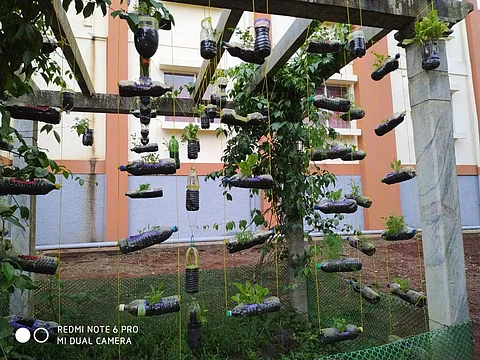

When you enter the College of Horticulture in Sirsi, you can see 700 plastic bottles hung along rails on the building walls and class corridors. They aren’t ordinary bottles – they have varieties of plants growing in them. This is part of a ‘green initiative’ started by Prof Shivanand Hongal, Vegetable Science Department, College of Horticulture, who happened upon this idea when he visited Israel to attend a conference on Agricultural Sciences. “A farmer in Israel had used plastic bottles to grow ornamental plants on his farm and I was fascinated by the idea. When I came back to India, I observed that many plastic bottles were disposed of during events in the college. I decided to make the best use of these bottles,” says Shivanand who points out that his students were instrumental in making the initiative a reality.
“This initiative wouldn’t have been a success without the contribution of my students. In the beginning, I divided them into groups and assigned them each a spot to do this ‘plastic bottle gardening’. Since we were doing it for the first time, we were not sure of what particular vegetables can be grown in it. Gradually, we understood that we could grow green leafy vegetables, onion, radish and garlic. Bottles have to be cut in a horizontal shape to grow greens like spinach, coriander, Amaranthus. For vegetables like the radish that grows along with roots, the bottle has to be cut vertically. Similarly, all plastic bottles cannot be used to grow vegetables. Some bottle materials are very thin and they cannot hold the weight. Hence it is better to use plastic bottles which are very hard and are suitable to hold the weight," he adds.
Growing leafy vegetables during the rainy season in Sirsi – one of the areas in Karnataka that receives high rainfall - is often impossible as they rot easily, but this method has made that possible. The college staff has even started growing fruits like papaya, lemon and other vegetables in waste plastic buckets and bags on their library terrace. They have been receiving a good yield as well.
Prof Shivanand and his students have used coco peat powder to grow plants in the plastic bottles. He says, "Soil will lead to the bottle becoming heavy. When we use coco peat powder, it is lighter. We have also used some amount of NPK fertilisers to provide nutrients to the plants. But this is not harmful at all." At present, the students are working on aspects like standardisation of these bottles, and determining the optimal quantity of nutrients and water required for each vegetable and the diameter of the holes to supply water to them.
Here are the steps to create a self-watering plant in a plastic bottle
Choose a two-litre water bottle and make some holes in the upper part of the water bottle
Cut the bottle in half
Make a hole in the bottle cap and fix a thread in it. Turn the top of the bottle upside down and place it in the other half of the bottle
The thread must touch the bottom of the bottle which has water in it
Fill the top part with the soil and sow some seeds in it
As the water is supplied through the thread, small seeds will germinate into plants
